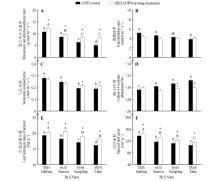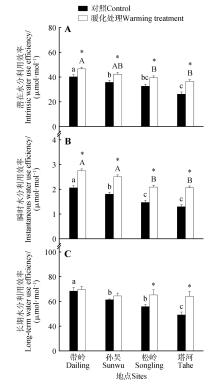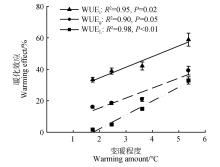Bulletin of Botanical Research ›› 2025, Vol. 45 ›› Issue (5): 686-694.doi: 10.7525/j.issn.1673-5102.2025.05.004
• Original Paper • Previous Articles Next Articles
Nan WANG1, Jingjing WANG2, Chuankuan WANG2, Xiankui QUAN2( )
)
Received:2025-03-28
Online:2025-09-20
Published:2025-09-28
Contact:
Xiankui QUAN
E-mail:quanxiankui@nefu.edu.cn
CLC Number:
Nan WANG, Jingjing WANG, Chuankuan WANG, Xiankui QUAN. Responses of Water Use Efficiency in Larix gmelinii to Simulated Climate Warming[J]. Bulletin of Botanical Research, 2025, 45(5): 686-694.
Table 1
Geographical and climatic conditions of L. gmelinii at the four transplanting sites and a common garden in Mao’ershan
地点 Site | 纬度 Latitude (N)/(°) | 经度 Longitude (E)/(°) | 年平均气温 Mean annual temperature/℃ | 平均年降水量 Mean annual precipitation/mm | 1月平均气温 Average temperature in January /℃ | 7月平均气温 Average temperature in July/℃ | 无霜期 Frost-free duration/d |
|---|---|---|---|---|---|---|---|
帽儿山 Mao’ershan | 45.40 | 127.50 | 3.10 | 629.00 | -18.5 | 22.0 | 140.0 |
带岭 Dailing | 47.08 | 128.90 | 1.34 | 621.27 | -22.0 | 20.3 | 139.0 |
孙吴 Sunwu | 49.22 | 127.20 | 0.62 | 554.08 | -25.5 | 19.5 | 90.0 |
松岭 Songling | 50.72 | 124.42 | -0.54 | 525.36 | -26.3 | 17.6 | 93.8 |
塔河 Tahe | 52.52 | 124.65 | -2.30 | 463.44 | -25.5 | 16.7 | 89.7 |
Table 2
Two-way analysis of variance of water use efficiency and related variables for L. gmelinii
变异来源 Source of variation | 最大净 光合速率 Pmax | 气孔导度 Gs | 蒸腾速率 Tr | 碳-13丰度 δ13C | 潜在水分 利用效率 WUEg | 瞬时水分 利用效率 WUEi | 长期水分 利用效率 WUEL | 叶氮含量 NL | 比叶面积 SLA |
|---|---|---|---|---|---|---|---|---|---|
地点 Site | 63.94** | 5.12** | 6.18** | 13.27** | 36.53** | 41.79** | 13.28** | 8.18** | 5.13** |
处理 Treatment | 57.90** | 1.79 | 3.89 | 6.61** | 159.92** | 186.11** | 6.62** | 13.14* | 14.83** |
地点 × 处理 Site × treatment | 2.92* | 3.82* | 2.15 | 2.90* | 4.95* | 2.79* | 2.91* | 2.94* | 3.42* |

Fig.1
Photosynthetic parameters, cabon-13 isotope abundance, and leaf traits of L. gmelinii under simulated climate warming treatmentsDifferent lowercase letters indicated significant differences between sites under controls at 0.05 level; different capital letters indicated significant differences between sites under simulated climate warming treatments at 0.05 level. * indicated significant differences between warming treatment and control in the same site at 0.05 level.


Fig.2
Water use efficiency of L. gmelinii needles under simulated climate warming treatmentsDifferent lowercase letters indicated significant differences between sites under control treatment at 0.05 level; different capital letters indicated significant differences between sites under simulated climate warming treatments at 0.05 level. * indicated significant differences between warming treatment and control in the same site at 0.05 level.


Fig.3
Relationships between warming effects of intrinsic water use efficiency(WUEg),instantaneous water use efficiency(WUEi),long-term water use effici-ency(WUEL) of L. gmelinii needles and warming amountWarming amount was the difference in mean annual temperature between Mao’ershan common garden and the transplanting site.

| [1] | 于贵瑞,高扬,王秋凤,等.陆地生态系统碳-氮-水循环的关键耦合过程及其生物调控机制探讨[J].中国生态农业学报(中英文),2013,21(1):1-13. |
| YU G R, GAO Y, WANG Q F,et al.Discussion on the key processes of carbon-nitrogen-water coupling cycles and biological regulation mechanisms in terrestrial ecosystem[J].Chinese Journal of Eco-Agriculture,2013,21(1):1-13. | |
| [2] | SAXE H, CANNELL M G R, JOHNSEN Ø,et al.Tree and forest functioning in response to global warming[J].New Phytologist,2001,149(3):369-399. |
| [3] | HUANG M T, PIAO S L, SUN Y,et al.Change in terrestrial ecosystem water-use efficiency over the last three decades[J].Global Change Biology,2015,21(6):2366-2378. |
| [4] | PICOTTE J J, ROSENTHAL D M, RHODE J M,et al.Plastic responses to temporal variation in moisture availability:consequences for water use efficiency and plant performance[J].Oecologia,2007,153(4):821-832. |
| [5] | KLEIN T, DI MATTEO G, ROTENBERG E,et al.Differential ecophysiological response of a major Mediterranean pine species across a climatic gradient[J].Tree Physiology,2013,33(1):26-36. |
| [6] | SCHULZE E D, TURNER N C, NICOLLE D,et al.Species differences in carbon isotope ratios,specific leaf area and nitrogen concentrations in leaves of Eucalyptus growing in a common garden compared with along an aridity gradient[J].Physiologia Plantarum,2006,127(3):434-444. |
| [7] | NIU S L, XING X R, ZHANG Z,et al.Water-use efficiency in response to climate change:from leaf to ecosystem in a temperate steppe[J].Global Change Biology,2011,17(2):1073-1082. |
| [8] | WAY D A, OREN R.Differential responses to changes in growth temperature between trees from different functional groups and biomes:a review and synthesis of data[J].Tree Physiology,2010,30(6):669-688. |
| [9] | REICH P B, SENDALL K M, RICE K,et al.Geographic range predicts photosynthetic and growth response to warming in co-occurring tree species[J].Nature Climate Change,2015,5(2):148-152. |
| [10] | PRIETO I, LEÓN-SÁNCHEZ L, NICOLÁS E,et al.Warming reduces both photosynthetic nutrient use efficiency and water use efficiency in Mediterranean shrubswarming reduces nutrient use efficiency[J].Environmental and Experimental Botany,2023,210:105331. |
| [11] | QUEREJETA J I, REN W, PRIETO I.Vertical decoupling of soil nutrients and water under climate warming reduces plant cumulative nutrient uptake,water-use efficiency and productivity[J].New Phytologist,2021,230(4):1378-1393. |
| [12] | 曹生奎,冯起,司建华,等.植物叶片水分利用效率研究综述[J].生态学报,2009,29(7):3882-3892. |
| CAO S K, FENG Q, SI J H,et al.Summary on the plant water use efficiency at leaf level[J].Acta Ecologica Sinica,2009,29(7):3882-3892. | |
| [13] | FARQUHAR G D, RICHARDS R A.Isotopic composition of plant carbon correlates with water-use efficiency of wheat genotypes[J].Australian Journal of Plant Physiology,1984,11(6):539-552. |
| [14] | 任书杰,于贵瑞.中国区域478种C3植物叶片碳稳定性同位素组成与水分利用效率[J].植物生态学报,2011,35(2):119-124. |
| REN S J, YU G R.Carbon isotope composition(δ 13C) of C3 plants and water use efficiency in China[J].Chinese Journal of Plant Ecology,2011,35(2):119-124. | |
| [15] | 蔡锦枫,薛子静,黄康祥,等.梅里雪山植物稳定碳同位素组成及其内在水分利用效率随海拔梯度的变化[J].生态学杂志,2024,43(6):1558-1565. |
| CAI J F, XUE Z J, HUANG K X,et al.Changes in stable carbon isotope composition and intrinsic water use efficiency of plants along an altitude gradient in the Meili Snow Mountain[J].Chinese Journal of Ecology,2024,43(6):1558-1565. | |
| [16] | GOWER S T, RICHARDS J H.Larches:deciduous conifers in an evergreen world[J].Bioscience,1990,40(11):818-826. |
| [17] | 国家林业和草原局.中国森林资源报告[M].北京:中国林业出版社,2019:275-365. |
| National Forestry and Grassland Administration.China forest resources report[M].Beijing:China Forestry Publishing House,2019:275-365. | |
| [18] | LEE J Y, MAROTZKE J, BALA G,et al.Future global climate:scenario-based projections and near-term information[M]// MASSON-DELMOTTE V,ZHAI P,PIRANI A,et al.Climate change 2021:the physical science basis.Cambridge:Cambridge University Press,2021:553-672. |
| [19] | JU Y L, WANG C K, WANG N,et al.Transplanting larch trees into warmer areas increases the photosynthesis and its temperature sensitivity[J].Tree Physiology,2022,42(12):2521-2533. |
| [20] | 苏波,韩兴国,李凌浩,等.中国东北样带草原区植物δ 13C值及水分利用效率对环境梯度的响应[J].植物生态学报,2000,24(6):648-655. |
| SU B, HAN X G, LI L H,et al.Responses of δ 13C value and water use efficiency of plant species to environmental gradients along the grassland zone of northeast China transect[J].Chinese Journal of Plant Ecology,2000,24(6):648-655. | |
| [21] | 季子敬,全先奎,王传宽.兴安落叶松针叶解剖结构变化及其光合能力对气候变化的适应性[J].生态学报,2013,33(21):6967-6974. |
| JI Z J, QUAN X K, WANG C K.Variations in leaf anatomy of Larix gmelinii reflect adaptation of its photosynthetic capacity to climate changes[J].Acta Ecologica Sinica,2013,33(21):6967-6974. | |
| [22] | ROUSSEL M, LE THIEC D, MONTPIED P,et al.Diversity of water use efficiency among Quercus robur genotypes:contribution of related leaf traits[J].Annals of Forest Science,2009,66(4):408. |
| [23] | 刘飞,刘攀,曹铭,等.稳定同位素技术在植物水分关系研究中的应用综述[J].生态科学,2020,39(6):224-232. |
| LIU F, LIU P, CAO M,et al.Review on applications of stable isotope technique in the study of plant and water relation[J].Ecological Science,2020,39(6):224-232. | |
| [24] | GOLLUSCIO R A, OESTERHELD M.Water use efficiency of twenty-five co-existing Patagonian species growing under different soil water availability[J].Oecologia,2007,154(1):207-217. |
| [25] | 梁逸娴,王传宽,臧妙涵,等.落叶松径向生长和生物量分配对气候变暖的响应[J].植物生态学报,2024,48(4):459-468. |
| LIANG Y X, WANG C K, ZANG M H,et al.Responses of radial growth and biomass allocation of Larix gmelinii to climate warming[J].Chinese Journal of Plant Ecology,2024,48(4):459-468. | |
| [26] | 李景浩,李慧,魏亚伟,等.樟子松、油松、蒙古栎水分利用效率种间变化及其对环境因子的响应差异[J].植物研究,2016,36(4):581-587. |
| LI J H, LI H, WEI Y W,et al.Water use efficiency of Pinus sylvestris,Pinus tabulaeformis,Quercus mongolica and their response differences to environmental factors[J].Bulletin of Botanical Research,2016,36(4):581-587. | |
| [27] | 史芮林,张庆芬,李铭,等.植物碳同位素分馏在水分利用效率研究中的应用[J].中国农学通报,2022, 38(23):15-20. |
| SHI R L, ZHANG Q F, LI M,et al.Application of plant carbon isotope fractionation in the study of water use efficiency[J].Chinese Agricultural Science Bulletin,2022,38(23):15-20. |
| [1] | Min ZHAO, Feng WANG, Jianan WANG, Qi YU, Hanguo ZHANG, Lei ZHANG. Selection of Superior Families of Larch Resistant to Pine Wood Nematode Disease [J]. Bulletin of Botanical Research, 2025, 45(5): 827-836. |
| [2] | Xiaoli LI, Xu SU, Dong WANG, Yuping LIU, Jinyuan CHEN, Chenglin SUN. Prediction of the Geographical Distribution Pattern of Rhodiola tangutica(Crassulaceae) under the Background of Climate Change, an Endemic Species from the Qinghai-Tibet Plateau [J]. Bulletin of Botanical Research, 2024, 44(2): 168-179. |
| [3] | Xiaohui HE, Jian GAO, Li ZHU, Ruimin HAO, Lei HUANG, jin ZHU, Li CHENG, Jie ZHOU. Response of Potential Geographic Distribution of Amygdalus mongolica to Climate Change [J]. Bulletin of Botanical Research, 2024, 44(2): 180-191. |
| [4] | Qian YANG, Yuan YUAN, Xu SU, Yuping LIU, Dong WANG, Xiaoli LI, Chenglin SUN, Ping YANG. Prediction of Suitable Distribution Area of Corydalis trachycarpa (Papaveraceae) in China under Climate Change [J]. Bulletin of Botanical Research, 2024, 44(1): 17-26. |
| [5] | Xinggang Tang, Yingdan Yuan, Jinchi Zhang. Effects of Climate Change on the Suitable Area and Niche of Cunninghamia lanceolata [J]. Bulletin of Botanical Research, 2022, 42(1): 151-160. |
| [6] | MA Peng-Yu, ZHANG Hong-Guang, ZAN Peng, GU Wei-Ping, WEN Lu-Ning, ZHANG Zi-Jia, WENG Hai-Long, SUN Tao, MAO Zi-Jun. Effects of Long-term Nitrogen Addition on Soil Enzymes in Larix gmelinii Plantation in Northeast China [J]. Bulletin of Botanical Research, 2019, 39(4): 598-603. |
| [7] | LI Ning-Ning, ZHANG Ai-Ping, ZHANG Lin, WANG Ke-Qing, LUO Hong-Yan, PAN Kai-Wen. Predicting Potential Distribution of Two Species of Spruce in Qinghai-Tibet Plateau under Climate Change [J]. Bulletin of Botanical Research, 2019, 39(3): 395-406. |
| [8] | LIU Ran, WANG Chun-Jing, HE Jian, ZHANG Zhi-Xiang. Analysis of Geographical Distribution of Abies in China under Climate Change [J]. Bulletin of Botanical Research, 2018, 38(1): 37-46. |
| [9] | LI Jing-Hao, LI Hui, WEI Ya-Wei, ZHANG Song-Zhu, ZHU Wen-Xu, DENG Ji-Feng, SONG Yi-Xuan, ZHOU Yong-Bin. Water Use Efficiency of Pinus sylvestris, Pinus tabulaeformis, Quercus mongolica and Their Response Differences to Environmental Factors [J]. Bulletin of Botanical Research, 2016, 36(4): 581-587. |
| [10] | YUAN Bo;BAI Hong-Ying*;ZHANG Jie;MA Xin-Ping. Vegetation Net Primary Productivity in Qinling Mountains and Its Response to Climate Change [J]. Bulletin of Botanical Research, 2013, 33(2): 225-231. |
| [11] | DI Xiao-Yan;CHI Xi-Mei;CHEN Jian-Wen;WANG Meng-Ben*. Comparison of Photosynthesis Characteristics in Five Provenances of Chinese Pine(Pinus tabulaeformis Carr.) [J]. Bulletin of Botanical Research, 2012, 32(2): 165-170. |
| [12] | MA Li-Xiang;WANG Xiu-Wei;MAO Zi-Jun*;LIU Lin-Xin;SUN Tao. Variations in Photosynthetic Capacity and Growth Characters for 2-Needled Pine from Diverse Geographic Populations [J]. Bulletin of Botanical Research, 2010, 30(6): 680-684. |
| [13] | DI Xiao-Yan;ZHU Xiao-Qi;MA Jian-Ping;CHI Xi-Mei;CHEN Jian-Wen;WANG Meng-Ben*. Effects of Soil Water Stress on Photosynthetic Characteristics in Five Provenances of Chinese Pine(Pinus tabulaeformis Carr.) [J]. Bulletin of Botanical Research, 2009, 29(5): 539-543. |
| [14] | DONG Deng-Feng;LI Yang-Rui*;JIANG Li-Geng. Synergistic Effects of Long-lasting Brassinosteroid TS303 and Prophyl Dihydrojasmonate on Enhancing Photosynthetic Capacity of Soybean [J]. Bulletin of Botanical Research, 2008, 28(6): 751-756. |
| [15] | CHEN Jie;MAO Zi-Jun*;MA Li-Xiang;XIA Ying-Ying. Response of Photosynthetic Capacity and Chlorophyll Fluorescence in Quercus mongolica and Tilia amurensis Seedlings after Light Intensity Transfe [J]. Bulletin of Botanical Research, 2008, 28(4): 471-476. |
| Viewed | ||||||
|
Full text |
|
|||||
|
Abstract |
|
|||||